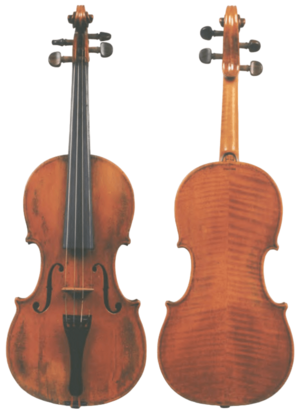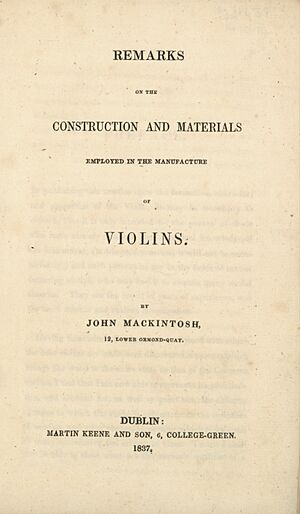John Mackintosh (luthier) facts for kids
Quick facts for kids
John Mackintosh
|
|
|---|---|
| Seán Mac an Taoisigh | |

Violin by Mackintosh, c. 1817
|
|
| Born | c. 1780 |
| Died | 1841 (aged 60–61) Dublin, Ireland
|
| Education | Thomas Perry |
| Known for | Luthier |
|
Notable work
|
violin, NMI collection |
| Style |
|
| Movement | Irish school |
| Children | Robert J. Mackintosh (son) |
John Mackintosh (also spelled John Macintosh), whose Irish name was Seán Mac an Taoisigh, was a talented luthier (a person who makes or repairs string instruments like violins) and a professor. He lived and worked in Dublin, Ireland, from around 1780 until his death in 1841.
Late in his life, he wrote a short book about how to make violins and about the famous "Cremonese school" of violin making. One of the violins he made is now kept in the National Museum of Ireland in Dublin.
Contents
John Mackintosh's Early Life
We don't know much about John Mackintosh's early years. While he spent most of his adult life in Dublin, some people believe he was born in Scotland.
His Career as a Luthier
Learning the Craft: 1808–1817
John Mackintosh likely started learning how to make violins in the early 1800s. He became an apprentice (a student learning a trade from a skilled master) to a Dublin instrument maker named Thomas Perry. He trained with Perry at 6 Anglesea Street between 1808 and 1817.
After finishing his training, Mackintosh opened his own workshop in 1817. His shop was at 1 Essex Quay in Dublin. This area was a popular spot for skilled craftspeople, including watchmakers, clockmakers, and other musical instrument makers, during the early 1800s. It's thought that Mackintosh even shared his workshop with a pipemaker named Timothy Kenna.
Later Career and Experiments: 1819–1841
In 1819, Mackintosh moved his workshop to 10 Essex Quay, where he worked until 1824. Another former apprentice of Perry's, John Dollard, also had a shop nearby.
In 1825, Mackintosh moved again, this time to 11 Astor's Quay. This was another area known for famous Dublin luthiers, like George Ward. From 1834 onwards, Mackintosh lived and worked at 12 Lower Ormond Quay with his son, Robert J. Mackintosh. Robert was a music professor and a very good violinist.
In 1837, John Mackintosh published a short book called Remarks on the Construction and Materials Employed in the Manufacture of Violins. In his book, he wrote about important topics like the best wood to use, how to get a good tone, and the importance of the bridge and sound post. He also discussed the famous Cremonese school of violin making.
He believed it was very important to choose high-quality, aged wood with specific types of pores. He also argued that new violins could be just as good as old ones if made correctly. Mackintosh continued to work at Lower Ormond Quay until he passed away in 1841.
His Unique Style and Techniques
John Mackintosh's style of violin making was typical of the "Irish school," but it was also greatly influenced by the famous Cremonese style from Italy. During his apprenticeship, he learned to make violins based on the Amati model. His teacher, Thomas Perry, had started using this model instead of the older Stainer model. Perry had even studied a real Amati instrument that was lent to him by the Duke of Leinster.
Mackintosh often branded his violins on the back with 'MACKINTOSH/DUBLIN'. This was a common practice among Irish violin makers. He based his violins on famous Italian models, including those by Amati, Stradivari, and Guarneri. In his 1837 book, Mackintosh wrote that he had carefully studied instruments from all these makers, especially Stradivari, as he had worked on several of Stradivari's violins.
Mackintosh also experimented a lot to try and copy the sound of old Italian master instruments. He tried many methods, like "steaming, steeping, stoving, boiling, and baking the timber." He also used different liquids like spirits, caustics, and acids. However, he found that these methods often damaged the wood. He claimed to have discovered a special process that allowed him to make instruments as good as the old Cremona ones. He said that about 16 years before his book (around 1821), he made three violins using a special kind of wood, and their owners reported they were as good as any Cremona instrument.
|
|||||||||||||||||||||||||||||||||||||||||||||||||||||||||||||||||||||||||||||||||||||||||||||||||||||||||||||||||||||||||||||||||||||||||||||||||||||||||||||||||||||||||||||||||||||||||||||||||||||||||||||||||||||||||||||||||||||||||||||||||||||||||||||||||||||||||||||||||||||||||||||||||||||||||||||||||||||||||||||||||||||||||||||||||||||||||||||||||||||||||||||||||||||||||||||||||||||||||||||||||||||||||||||||||||||||||||||||||||||||||||||||||||||||||||||||||||||||||||||||||||||||||||||||||||||||||||||||||||
|
|||||||||||||||||||||||||||||||||||||||||||||||||||||||||||||||||||||||||||||||||||||||||||||||||||||||||||||||||||||||||||||||||||||||||||||||||||||||||||||||||||||||||||||||||||||||||||||||||||||||||||||||||||||||||||||||||||||||||||||||||||||||||||||||||||||||||||||||||||||||||||||||||||||||||||||||||||||||||||||||||||||||||||||||||||||||||||||||||||||||||||||||||||||||||||||||||||||||||||||||||||||||||||||||||||||||||||||||||||||||||||||||||||||||||||||||||||||||||||||||||||||||||||||||||||||||||||||||||||
Violins Still Around Today
We don't know exactly how many instruments John Mackintosh made because he didn't number them. However, one of his violins is kept in the National Museum of Ireland. It's part of a collection of musical instruments made by Irish craftsmen. This collection also includes instruments by other luthiers from the 1700s and 1800s, like Mackintosh's teacher Perry, as well as John Delany, Thomas Molyneux, and George Ward.
Here are a few of Mackintosh's instruments that are still known to exist:
- 1815: This violin was sold in September 1992.
- c. 1817: This one is labeled 'Made by John Mackintosh, No. 1 Essex Quay, Dublin'.
- (?): One is in the National Museum of Ireland, Dublin.
- (?): Another is branded 'McIntosh of Dublin'.
See also
- Thomas Perry (luthier)
- William Ringwood


